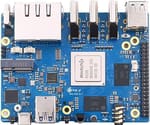Don’t let the size fool you, the Orange Pi 5 Plus could be everything you need in an SBC – and maybe a little more. SBCs seem to increasingly be taking the place of traditional and clumsy desktops. Tasks that one could previously only do with a dedicated graphics card, such as connecting up to three monitors simultaneously, are starting to become a reality with today’s powerful ARM processors.
While the upgrade to more powerful resources means your wallet may end up a bit lighter, you may also find this single device can encompass functions that would have previously required additional equipment such as a network switch or external storage driver. All the features in a compact board like the Orange Pi 5 Plus make it a very interesting option for robotics and entertainment, so let’s take a clear look at what this device has to offer!
Features
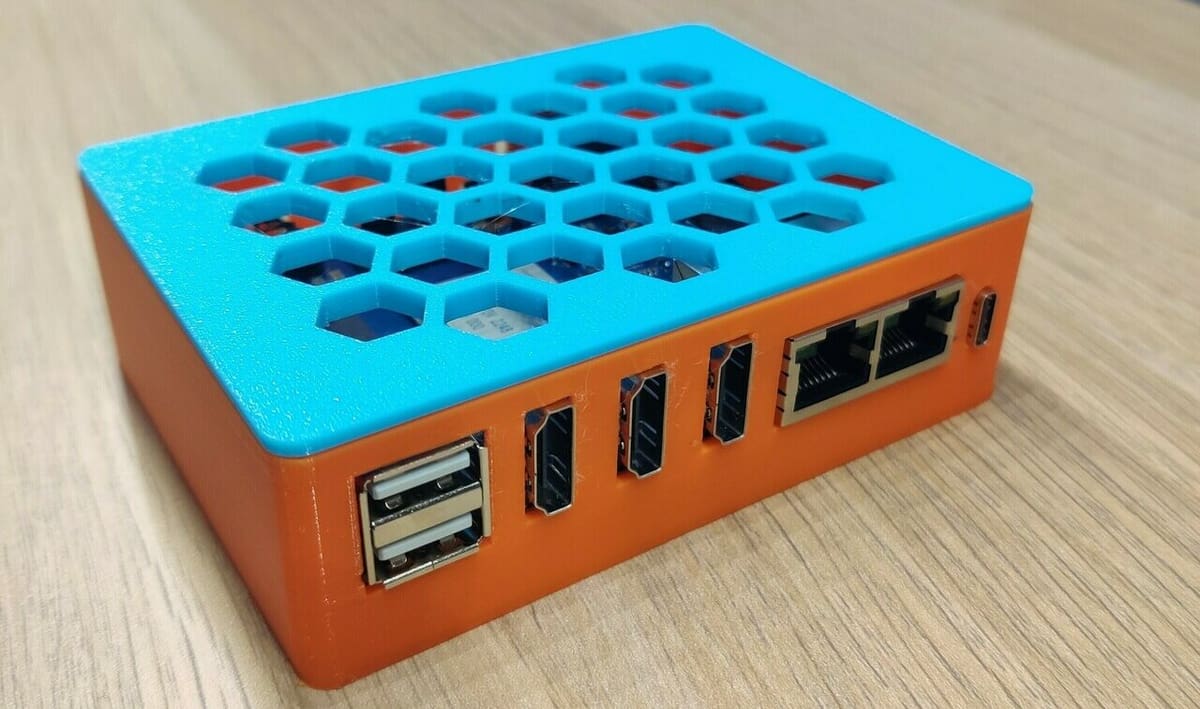
The 5 Plus is Orange Pi’s most powerful board to date! It’s made significant upgrades from its predecessor, the Orange Pi 5. Let’s check it out below:
Rockchip RK3588 & Mali-G610 Processors
At the heart of this system, we find eight processing cores housed in 64-bit architecture with 8-nm lithography. Four of the cores are low-power, running at 1.8 GHz, while the other four are performance cores that run at 2.4 GHz.
The performance of the RK3588 processor doesn’t differ much from the one used in the Orange Pi 5, which runs on the RK3588S, although both offer top performance for their class, as benchmarked by Jeff Geerling. The floating-point computing power (HPL) of the 5 Plus reaches an impressive 53 GigaFLOPS, which is enough to leave both the Raspberry Pi 5 and Rock 5 Model B behind.
A Mali-G610 GPU with four 600-MHz cores offers performance that has made a good impression on users. The capabilities include 8K video decoding; 4x, 8x, and 16x MSAA (anti-aliasing) options; and features such as Adaptive Scalable Texture Compression (ASTC). Its Arm Frame Buffer Compression (AFBC) optimizes memory usage, performance, and energy consumption.
Robust Storage
Regardless of your objective with an SBC, it’s desirable to have the space and speed for your systems and files, which is why the 5 Plus has a greater emphasis on storage capacity in comparison to the Orange Pi 5.
The 5 Plus features two M.2 sockets, one for the 2230 standard and the other for the 2280 standard, which can reach speeds of up to 2,000 MB/s. Even if you use a card for wireless connectivity in the 2230 standard socket, you can still count on options such as the SD card slot and eMMC socket with a capacity of up to 256 GB.
Ports and Interface Options
In addition to expanding its storage capacity, the 5 Plus also sought to address user connectivity needs. The 5 Plus includes two 2.5 GB/s network ports, an IR receiver, connections for an RTC battery and speaker, a built-in microphone, interfaces for a touchscreen, LCD, and MIPI camera, plus a total of five USB ports (two USB 2.0 standard, two USB 3.0, and another UBS Type C – which doubles as a DisplayPort). Unlike its predecessor, the 5 Plus has a 40-pin GPIO expansion header and three full HDMI video connectors, two of which are outputs and the other an input.
Software
In terms of operating systems, there’s a good variety of options listed on the official Orange Pi page, and the 5 Plus has plenty of space to accommodate them, thanks to an eMMC socket capable of storing up to 256 GB. The main Linux distributions – such as Ubuntu, Debian, and OpenWRT – run without problems, but there are also versions of Orange Pi OS (Droid and Arch) that are also available.
Reviews
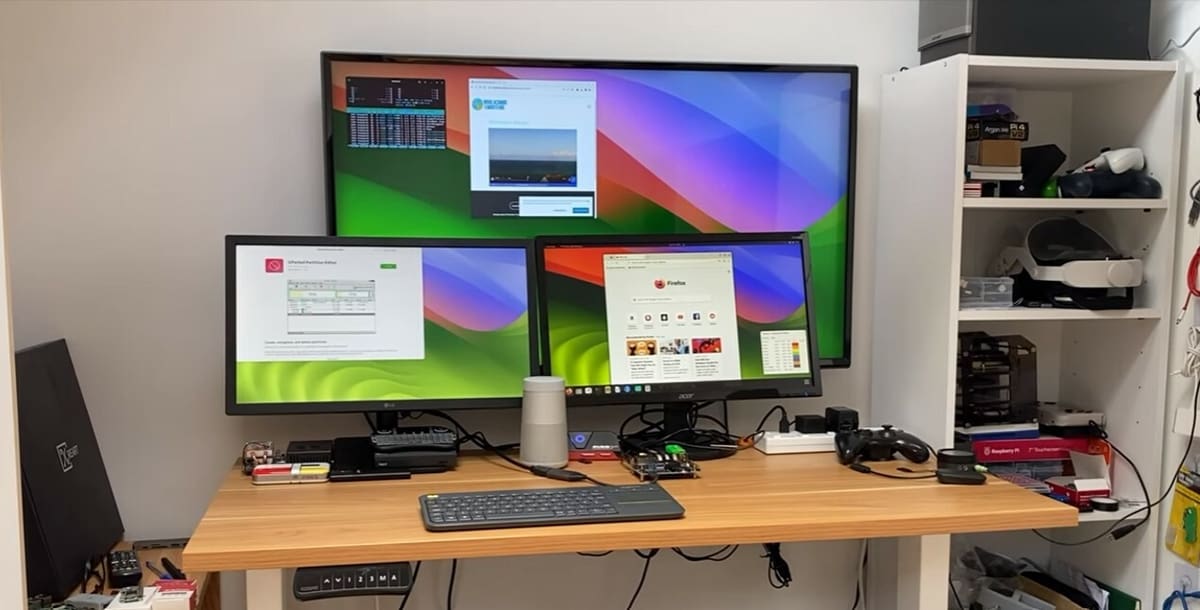
Although the Orange Pi 5 Plus arrived only recently, there is already much praise for this powerful SBC. Let’s check out what the masses have been saying.
The first thing you’ll notice about this board is its Pico-ITX form factor, which is the same standard as the Rock 5 Model B. Some users are praising that so much is included on the 5 Plus despite its size. The RK3588 processor allows for the inclusion of several additional ports, and this can make a big difference in many projects. Check out the review of Helping Ninja for a quick overview.
The video display upgrades have also been praised. With the 5 Plus, it’s possible to connect up to three monitors simultaneously (including one monitor connected via the DP connection of the USB-C port). Given we’re talking about SBCs, a very heavy game will not be fluid with more than one screen, but multitasking with multiple windows seemed to be no problem for the Mali GPU in testing by leepspvideo.
With its impressive performance, the 5 Plus has proved to be a great option for emulation and Android games. This is clearly demonstrated in the review from ETA Prime, where several games such as Asphalt 9, Gran Turismo 4, and Call of Duty mobile were running without crashes or bottlenecks.
Specs
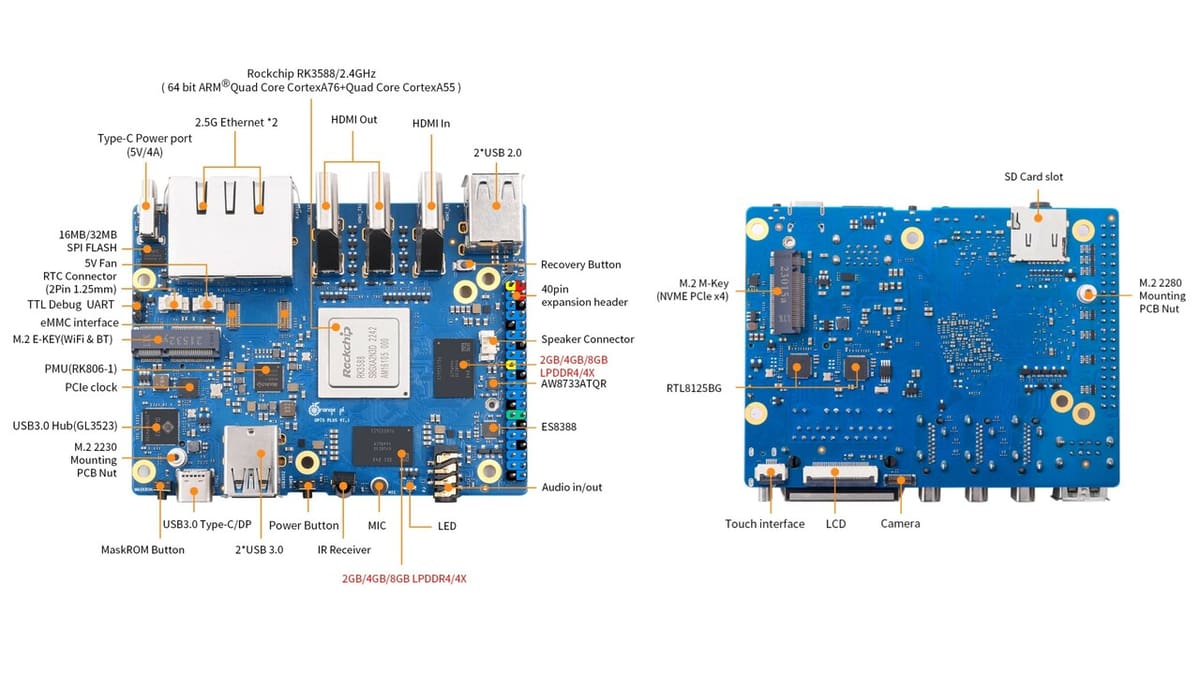
Here’s a summary of what you’ll find in this SBC:
- CPU: 8-core 64-bit Rockchip RK3588
- GPU: Arm Mali-G610 MP4 “Odin”
- NPU: Up to 6Tops, supports INT4/INT8/INT16/FP16 mixed operation
- Memory: 4, 8, 16 or 32 GB (LPDDR4/4x)
- Built-in storage: MicroSD (TF) card slot, eMMC socket, 2x M.2 M-Key sockets (supports SSD or PCIe Wi-Fi 6 plus BT 5.0)
- Wireless connectivity: Nothing built-in
- Ports and slots: 2x USB 2.0, 2x USB 3.0, USB Type-C, UART, PWM, I2C, SPI, CAN, 40-pin GPIO
- Size: 75 x 100 mm, 86.5 g
- Input voltage: 5 V, Type C
Price
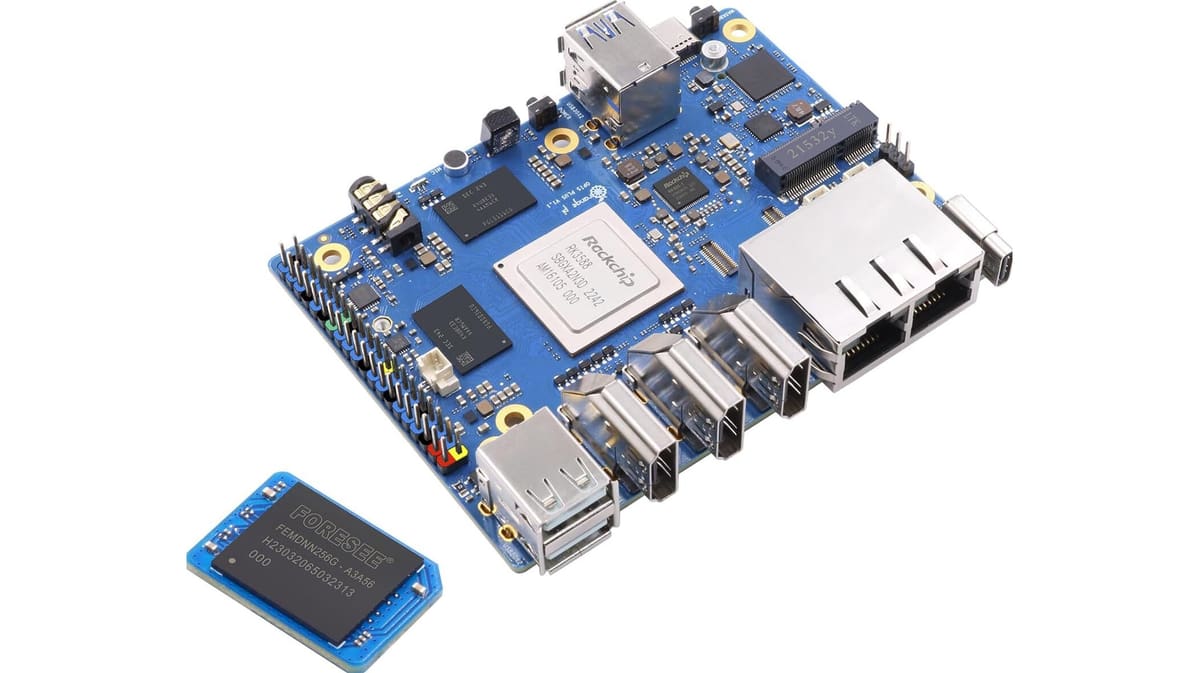
As we have seen so far, the Orange Pi 5 Plus has a lot to offer, but how much will it set you back?
Checking out the online markets, it’s understandable how this board has captured many hearts! While the Rock 5 Model B with 4 GB of RAM starts at around $130, the same RAM capacity on the Orange Pi 5 Plus can be found for around $100 on Aliexpress and at Amazon at the time of writing (although don’t expect additional kit components at this price).
As with other successful cards, the 32-GB RAM version of the Orange Pi 5 Plus is not easy to find. From what we’ve seen, its price is around $160 to $180, making it a great option compared to the Rock Pi 5 Model B if you can get your hands on it.
If you prefer to jump in and buy a complete kit with 256-GB eMMC, power supply, case, antennas, PCIe WiFi 6 and Bluetooth module, aluminum radiator, and 32-GB MicroSD card, the best-selling kit on AliExpress at the moment goes for around $210. You can also try to save some money by 3D printing your own case with many options available on repository websites like Printables and Cults.
Similar Devices

Finally, let’s look at similar options out there.
Radxa Rock 5 Model B
Radxa caught a lot of market attention with this model despite the high prices. Perhaps it sparked some inspiration for the Orange Pi 5 Plus, since it features the same processor as the Rock 5 Model B. The similarities continue with the size and socket options, eMMC, and M.2 and dual full-size HDMI outputs. However, the Rock 5 B only has one 2.5-GB LAN port, while we get two in the Orange Pi. Neither board has integrated wireless connections.
Orange Pi 5
When we look at the predecessor of the Orange Pi 5 Plus, both its size as well as the number of ports and interfaces draw a lot of attention. While the original Orange Pi 5 is not as big as the Plus version, it’s also not as small as the Raspberry Pi 5. The overall performance of the Orange Pi 5, however, is comparable to the 5 Plus. Perhaps the biggest advantage of this card is its price, which starts at around $70 for the 4-GB RAM version.
Raspberry Pi 5
We couldn’t write about the Orange Pi 5 Plus without comparing it to the Raspberry Pi 5. While not very similar in size and number of ports, the Raspberry Pi 5 still manages to deliver considerable performance and stability with the addition of, unlike other options, support for wireless connections (Wi-Fi and Bluetooth). With a smaller form factor, it’s priced at around $60, but given it launched just a short time ago, it won’t be so easy to find it in stores.
License: The text of "Orange Pi 5 Plus: Specs, Price, Release & Reviews" by All3DP is licensed under a Creative Commons Attribution 4.0 International License.
CERTAIN CONTENT THAT APPEARS ON THIS SITE COMES FROM AMAZON. THIS CONTENT IS PROVIDED ‘AS IS’ AND IS SUBJECT TO CHANGE OR REMOVAL AT ANY TIME.
